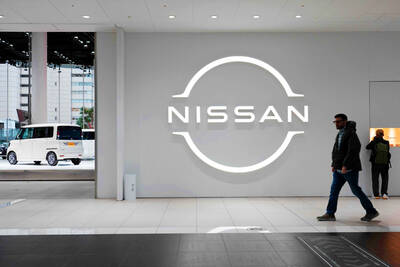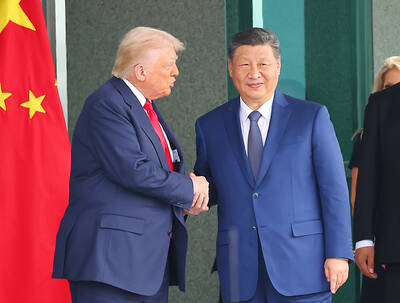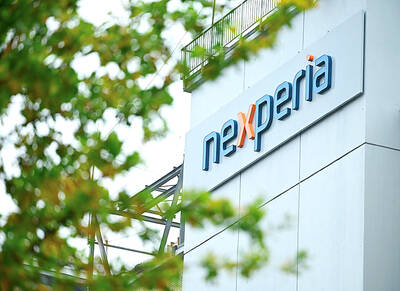Alibaba Group Holding Ltd (阿里巴巴) cofounder Jack Ma (馬雲)-backed Ant Group Co (螞蟻集團) used Chinese-made semiconductors to develop techniques for training artificial intelligence (AI) models that would cut costs by 20 percent, people familiar with the matter said.
Ant used domestic chips, including from Alibaba and Huawei Technologies Co (華為), to train models using the so-called “mixture of experts” machine learning approach, the people said.
It got results similar to those from Nvidia Corp chips, such as the H800, they said.

Photo: AFP
Hangzhou-based Ant is still using Nvidia for AI development, but is now relying mostly on alternatives, including from Advanced Micro Devices Inc and Chinese chips for its latest models, one of the people said.
The models mark Ant’s entry into a race between Chinese and US companies that has accelerated since DeepSeek (深度求索) demonstrated how capable models can be trained for far less than the billions invested by OpenAI and Alphabet Inc’s Google.
It underscores how Chinese companies are trying to use local alternatives to the most advanced Nvidia semiconductors. While not the most advanced, the H800 is a relatively powerful processor and is barred by the US from China.
The company published a research paper this month that said its models at times outperformed Meta Platforms Inc in certain benchmarks, which has not been independently verified.
However, if they work as advertised, Ant’s platforms could mark another step forward for Chinese AI development by slashing the cost of inferencing or supporting AI services.
Ant said it cost about 6.35 million yuan (US$875,952) to train 1 trillion tokens using high-performance hardware, but its optimized approach would cut that down to 5.1 million yuan using lower-specification hardware.
Tokens are the fundamental units of text — such as words, characters or parts of words — that a language model breaks down and analyzes to understand context, meaning and structure.
In essence, they are the building blocks that enable the model to interpret human language and produce intelligent output.
The company plans to leverage the recent breakthrough in the large language models it has developed, Ling-Plus and Ling-Lite, for industrial AI solutions including healthcare and finance, the people said.
On English-language understanding, Ant in its paper said that the Ling-Lite model did better in a key benchmark compared with one of Meta’s Llama models.
Ling-Lite and Ling-Plus models outperformed DeepSeek’s equivalents on Chinese-language benchmarks.
Ant has made the Ling models open-source. Ling-Lite contains 16.8 billion parameters, which are adjustable settings that work like knobs and dials to direct the model’s performance.
Ling-Plus has 290 billion parameters, which is considered relatively large in the realm of language models. For comparison, experts estimate that ChatGPT’s GPT-4.5 has 1.8 trillion parameters, MIT Technology Review said. DeepSeek-R1 has 671 billion.
The company faced challenges in some areas of the training, including stability.
Even small changes in the hardware or the model’s structure led to problems, including jumps in the models’ error rate, it said in the paper.
Additonal reporting by staff writer

Nissan Motor Co has agreed to sell its global headquarters in Yokohama for ¥97 billion (US$630 million) to a group sponsored by Taiwanese autoparts maker Minth Group (敏實集團), as the struggling automaker seeks to shore up its financial position. The acquisition is led by a special purchase company managed by KJR Management Ltd, a Japanese real-estate unit of private equity giant KKR & Co, people familiar with the matter said. KJR said it would act as asset manager together with Mizuho Real Estate Management Co. Nissan is undergoing a broad cost-cutting campaign by eliminating jobs and shuttering plants as it grapples

PERSISTENT RUMORS: Nvidia’s CEO said the firm is not in talks to sell AI chips to China, but he would welcome a change in US policy barring the activity Nvidia Corp CEO Jensen Huang (黃仁勳) said his company is not in discussions to sell its Blackwell artificial intelligence (AI) chips to Chinese firms, waving off speculation it is trying to engineer a return to the world’s largest semiconductor market. Huang, who arrived in Taiwan yesterday ahead of meetings with longtime partner Taiwan Semiconductor Manufacturing Co (TSMC, 台積電), took the opportunity to clarify recent comments about the US-China AI race. The Nvidia head caused a stir in an interview this week with the Financial Times, in which he was quoted as saying “China will win” the AI race. Huang yesterday said

TEMPORARY TRUCE: China has made concessions to ease rare earth trade controls, among others, while Washington holds fire on a 100% tariff on all Chinese goods China is effectively suspending implementation of additional export controls on rare earth metals and terminating investigations targeting US companies in the semiconductor supply chain, the White House announced. The White House on Saturday issued a fact sheet outlining some details of the trade pact agreed to earlier in the week by US President Donald Trump and Chinese President Xi Jinping (習近平) that aimed to ease tensions between the world’s two largest economies. Under the deal, China is to issue general licenses valid for exports of rare earths, gallium, germanium, antimony and graphite “for the benefit of US end users and their suppliers

Dutch chipmaker Nexperia BV’s China unit yesterday said that it had established sufficient inventories of finished goods and works-in-progress, and that its supply chain remained secure and stable after its parent halted wafer supplies. The Dutch company suspended supplies of wafers to its Chinese assembly plant a week ago, calling it “a direct consequence of the local management’s recent failure to comply with the agreed contractual payment terms,” Reuters reported on Friday last week. Its China unit called Nexperia’s suspension “unilateral” and “extremely irresponsible,” adding that the Dutch parent’s claim about contractual payment was “misleading and highly deceptive,” according to a statement